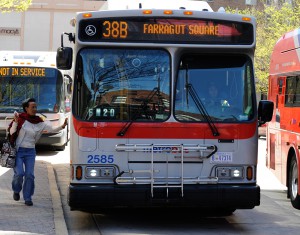Metrobus Ridership During the Rail Safety Shutdown
When Metrorail closed on March 16th, tens of thousands of rail riders switched to bus, including almost 20,000 riders who took their first bus ride in over a month! Bus-to-bus transfers spiked 45%, and ridership surged in downtown and central areas but fell in the suburbs.
Special thanks to the Systems & Performance Analysis team in Bus Planning for their help developing this analysis.
When Metrorail closed on Wednesday, March 16, Metrobus braced for impact as over 700,000 displaced rail trips sought alternatives. But there was little time or capacity to significantly alter bus service. What happened to bus ridership?
Overall ridership as tallied by the farebox came in at just 5% over the monthly average, or about 20,000 additional trips. So the changes look fairly small given the volume of displaced rail trips.
But don’t be fooled by the bottom line. Underneath that total, a seismic shift was taking place.
Geographically, bus lines in downtown D.C. and inner neighborhoods gained riders, while lines in the suburbs lost riders. Buses serving downtown D.C. were up 30%. (Western NOVA includes the 38B, which led that sector’s increase).
The biggest gains that day were on bus lines that serve similar markets as Metrorail. The top six lines for ridership increases were:
The biggest losses that day were from routes that depend on rail, such as the A routes serving Anacostia station (down 18%), the 16s on Columbia Pike that terminate at Pentagon (down 25%), Metroway (down 53%), and the NH1 (down 42%). Smaller feeder bus routes were hit the hardest – some even lost over half their riders, like B29, B31 Crofton-New Carrollton (down 59%), or the C11, C13 in Clinton (down 92%).
In addition, on March 16th we saw “crossover” of around 50,000-80,000 bus trips from riders who normally ride rail. As the chart below shows, nearly 27,000 rail riders switched to bus that day. What the chart doesn’t show you is that of these rail riders, almost 20,000 were taking their first bus trip in over a month.
Amid the rail shutdown, we also saw evidence of some of our riders’ transit dependence as bus-to-bus transfers spiked 45% that day, by over 35,000 transfers. These represent riders who needed to take two buses that day instead of one. The growth in bus-to-bus transfers are concentrated on the same bus routes that increased generally that day (38B, 30s, P6, Viers Mill, Georgia Avenue, 80, etc.), suggesting that many riders took a bus to reach these bus routes.
Still, it’s not clear where all 700,000 displaced rail trips went, and we may never have a full answer. We can say they didn’t all take Metrobus! Overall congestion levels on the roads were up moderately, suggesting some drove. DC’s bike counters and Capital Bikeshare trips were up that day too, but not at a scale that could explain hundreds of thousands of trips. Many riders likely changed their plans abruptly for the day (like a snow day), and/or stayed home.
What did you do on the day Metrorail was closed? Did you ride a Metrobus?






The loss of Metrobus riders in the suburbs is especially striking because Metrobus routes in the suburbs tend to be trunk routes, while the buses operated by the jurisdictions are more heavily the routes that feed Metrorail. So overall, the loss of suburban bus ridership is undoubtedly even more severe than these data suggest.
The lesson for transportation planning is that buses & rail, especially outside dense cities, are complementary rather than substitutes for each other.
One other detail — the Q routes on Veirs Mill also run parallel to the Red Line on Georgia and Route 355 — there, and not on Veirs Mill itself, is probably where they gained ridership
I rode the 39 bus in from Capitol Hill to Downtown. The morning ride in was a breeze.
(also, as a note: all-day, bi-directional Metro Extra services are great. It’s too bad that the 39 bus doesn’t run all day and doesn’t run in both directions. It would be great to see WMATA shift some existing buses out of the normal 30s patterns, and have them operate the limited stop 39 route all day, both directions. All of the Metro Extra services shouldn’t just be limited stop routes, they should be limited stop, all-day, bi-directional services.)
The afternoon ride home was a complete mess. I decided to start walking along the bus route from the Metro Center area to see how far I would get before seeing a 30s bus pass me. I made it about 3/4 of the way home before getting passed by a bus. Traffic was so jammed in Downtown that buses from the west side of the city couldn’t get through the congestion and emerge on the eastern side to finish their routes.
By that time, I just kept walking.